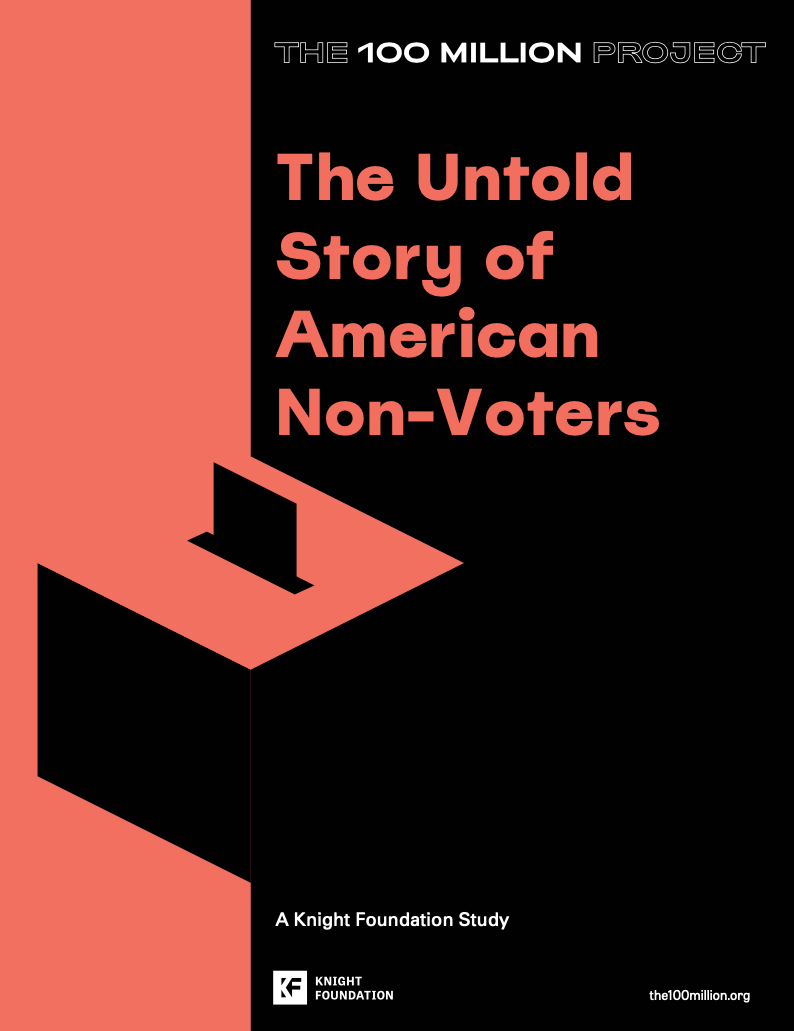The Untold Story of American Non-Voters
View our interactive website:
Executive Summary
In 2016, nearly 100 million eligible Americans did not cast a vote for president, representing 43% of the eligible voting-age population. They represent a sizeable minority whose voice is not heard in our representative democracy. Most of our attention, in politics and in research, tends to fall almost exclusively on “likely” voters perceived to make the most difference in the outcome. As a result, relatively little is known about those with a history of non-voting. Yet their non-participation is a key feature of our democracy, and raises important questions about the basic health of a participatory society.
To help understand this large segment of the population, the John S. and James L. Knight Foundation commissioned Bendixen & Amandi International to develop a comprehensive study of those who do not vote. This study surveyed 12,000 chronic non-voters nationally and in 10 swing states, soliciting their views, attitudes and behaviors on a wide range of topics. For comparison purposes, a group of 1,000 active voters who consistently participate in national elections and a group of 1,000 young eligible voters (18-24 years old) were also surveyed. Findings were further explored through in-depth conversations with non-voters in focus groups held around the country. The study reveals that persistent non-voters are by no means a monolithic group, but as varied as American society itself. There is not a one-size-fits-all description of the non-voting population, nor is there a single, unifying explanation for their lack of participation. They can be found across the political spectrum, at every level of education and income, and from every walk of life. There were, however, several themes that emerged from the study:
- Many non-voters suffer from a lack of faith in the election system and have serious doubts about the impact of their own votes: Thirty-eight percent of non-voters are not confident that elections represent the will of the people, and non-voters are more likely to say that this is because the system is rigged. Non-voters are less likely to believe votes are counted fully and accurately, or to say that decisions made by the president or others in Washington have a strong impact on their lives.
- Non-voters engaged less with news and are left feeling underinformed: Non-voters are twice as likely as active voters to passively encounter news versus actively seeking it out, and to say they do not feel they have enough information about candidates and issues to decide how to vote. Their media diets involve less news and more entertainment as compared to active voters.
- While less partisan, non-voters are more evenly divided on key issues and on President Trump than active voters: Non-voters showed slightly more support for constructing a wall along the Mexican border than active voters, while being less supportive of replacing the Affordable Care Act. If they all voted in 2020, non-voters would add an almost equal share of votes to Democratic and Republican candidates, but important differences exist across swing states.
- The emerging electorate is even less informed and less interested in politics: Young eligible citizens (18-24 years old) are even less likely than non-voters to report following political news, and feel less informed than non-voters come election time. Fewer are interested in voting in 2020 than non-voters, principally because they don’t care about politics. They also struggle the most with the voting process.
Introduction
There are more than 250,000,000 voting-aged individuals in the United States. While some are excluded from voting for elected leadership and ballot initiatives due to their criminal history or immigration status, the overwhelming majority of adults residing in this country are eligible to vote. Yet, even the most high-profile elections of the past decades only boast turnouts hovering in the 50-60% range – quite low in comparison to other developed countries. There are about 100,000,000 eligible voters in our country who do not vote at all. Yet they receive little to no attention in our national political discourse, or even in the specialized conversations among strategists and scholars about electoral participation.
The results of the recent 2016 presidential election – one of the most hotly contested races in recent memory – illustrate the magnitude and importance of this issue. In the simplest terms, the media reported the results of the election as follows: 65,853,514 votes for Hillary Clinton; 62,984,828 votes for Donald Trump; and 6,674,811 for other minor candidates.
Perhaps a more accurate reflection of the results of the 2016 presidential election might be:

In other words, the largest bloc of citizens in our presidential elections are not those who vote for one candidate or another, but those who do not participate in the election at all. Understanding their preferences, characteristics and behaviors sheds light on a series of questions that are crucial to understanding the state of American democracy:
- Why are so many Americans persistently disengaged from the political process?
- Who are they, and what do they care about?
- What would be the impact if they turned out to vote?
This study is the first comprehensive effort to understand this large segment of the American electorate.
Download the Full Report:
Additional Reading
How Media Habits Relate to Voter Participation
The John S. and James L. Knight Foundation published this report as part of the 100 Million project. The Foundation does not endorse any political party or candidate. It supports all efforts to educate non-voting Americans about the issues facing their communities and the nation and exercise the right to vote for candidates and initiatives of their choice.






